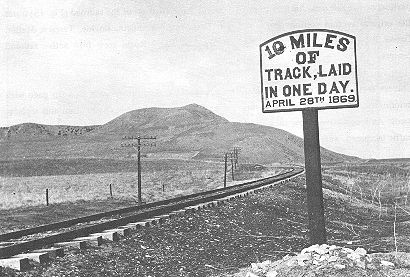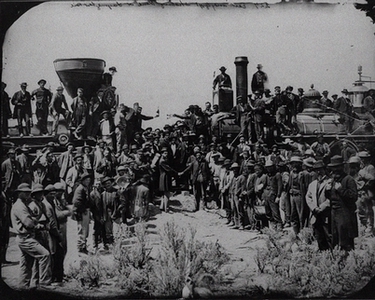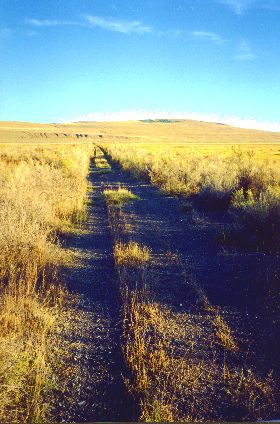
The work of the railroad men cannot be fully appreciated without first understanding the history behind the building of the first Transcontinental Railroad. The history of this great railroad goes back to the time when the first steam locomotives were moving on the first tracks in the nation. At this time, the Railroad was only an idea, and a dream. The first convention for the planning of the Pacific Railroad (as this first transcontinental railroad was called) was held in 1838 by John Plumbe. Pacific Railroad bills that proposed to grant lands, subsidies, and even as much as 90 million dollars towards the construction of this railroad had been periodically introduced in Congress since the 1840's. [McCague 4].
None of the bills passed, because a route could not be decided on. Congress was split along geographical lines; northerners wanted a northern route and southerners wanted a southern route. This was because of the issue of slavery in the "New West" [Howard 57]. Since the "New West" really was new, there really wasn't any slavery there yet. Congress was split over whether slavery should be permitted at all in these new states.
The discovery of gold near Sutter's mill in California in 1848 resulted in a huge influx of people lured by the promise of "free gold" into California during 1849: 55,000 by overland routes and another 25,000 by sea [Howard 64]. With so many people now heading west, travel and trade across the country became suddenly more important. By 1850, only 57% of the population of the United States lived east of the Alleghenies on the Atlantic seaboard [Howard 65].
That fact, along with the "Yankees' success in barring slavery in California, the popularity of the all-north California Trail, the railroads racing toward Chicago and St. Louis, worried the leaders of the Old South bloc in Congress" [Howard 65]. They pressed for the all southern route (the South & Pacific Railroad), which spurred the Gadsden Purchase in 1853 of 45,535 square miles of land south of the Gila River and east to El Paso del Norte [Howard 66]. With this land, the potential for an all southern route to California was clear.
However, Congress still could not decide on a route, so they sent five surveying teams out in 1853 to explore possible railroad routes to California. But California desperately needed railroads to replace the mule teams, stage coaches, and steamboats on which the entire economy was dependent [Howard 67]. So California's first railroad (the Sacramento Valley Railroad) was started in 1854, with Theodore D. Judah as its chief engineer.
The railroad surveying teams finished in autumn of 1854. The results of their research was reviewed by the Secretary of War, Jefferson Davis of Mississippi. He concluded that the southern route, running through the newly purchased Gadsden lands, would be the most cost-effective [Howard 84]. Jefferson Davis, of course, who went on to become the president of the Confederate States of America after the secession, had vested Southern interests.
Because of the bad blood involved, no action was taken on his decision; votes taken went against funding the Southern route, because of the split in Congress between Northern and Southern interests. Then, in 1861, the Southern congressmen left Congress as a precursor to Southern secession, whereupon action and funding progressed immediately to begin work on the Northern route. The North's final decision on a route, the central route through Nebraska, hinged greatly on analyses of how use of the Railroad would impact the impending Civil War, which had just broken out [Gordon 151].
In 1853, Grenville M. Dodge had "made a reconnaissance west of the Missouri river with a view of determining the location of the great Pacific Railroad of the future, and the bill authorizing the construction of the Pacific Railroad which was adopted by Congress in 1862 was mostly based upon his surveys and reports" [Granger 4].
By April of 1861 Theodore Judah finally brought together the Central Pacific Railroad Co., with president Leland Stanford, vice-president Collis P. Huntington, and treasurer Mark Hopkins. These three men: Stanford, Hopkins, and Huntington, along with Charles Crocker, who handled labor issues, became known as the "Big Four" of the Central Pacific Railroad. In 1862, Judah was appointed secretary of the House and Senate committees on the Pacific Railway Act, and so he finally got to see the beginning of the realization of his dream of a transcontinental railroad...before his death in 1863.

The other half of the plan, the Union Pacific Railroad Co., was founded in Chicago on September 2nd, 1862. By December 2nd, 1863, the Union Pacific broke ground on the Missouri River bluffs. With both companies now at work, the Railroad began to creep towards a meeting.
The work was progressing, albeit slowly on the western branch by the Central Pacific company. Then, in 1865, silver was discovered in Nevada. Though not the wild gold rush of 1849, it drew a large number of able bodied men to Nevada to search for silver, depleting the work force of the Central Pacific. With a choice between silver hunting, safe jobs in California, or dangerous work on the CP Railroad, fewer and fewer white workers were staying on with the railroad.
So, in 1865, Charles Crocker, amid much dispute, began hiring Chinese workers to fill in for the white labor shortage. This was a decision which profoundly changed the course of race relations in the West. Around the same time, the Union Pacific was having racial issues of their own. As they pushed across the prairie lands moving west, they began to constantly run up against Native American raiding parties. Some of the land across which the Railroad was being built had been bought by the government from white owners, but much more of it was simply taken from land previously promised to the Natives.
Charles Crocker's assistant was a man named James Harvey Strobridge. Strobridge was a hard man, who was in charge of making sure all of the Central Pacific workers, white and Chinese alike were doing their jobs. While Crocker handled the major hiring decisions, it was Strobridge out there on the line who was overseeing the day to day discipline and pushing the workers on.
Grenville Dodge was appointed Chief Engineer of the Union Pacific railroad in January 1866 [Granger 23]. A former "Indian fighter", his influence on the workers resulted in a constant state of readiness. When the workers weren't at work or asleep, they were at war, their rifles at their sides, ready for the next Indian attack. They kept on working though, and by 1869 were laying track at a phenomenal rate.


